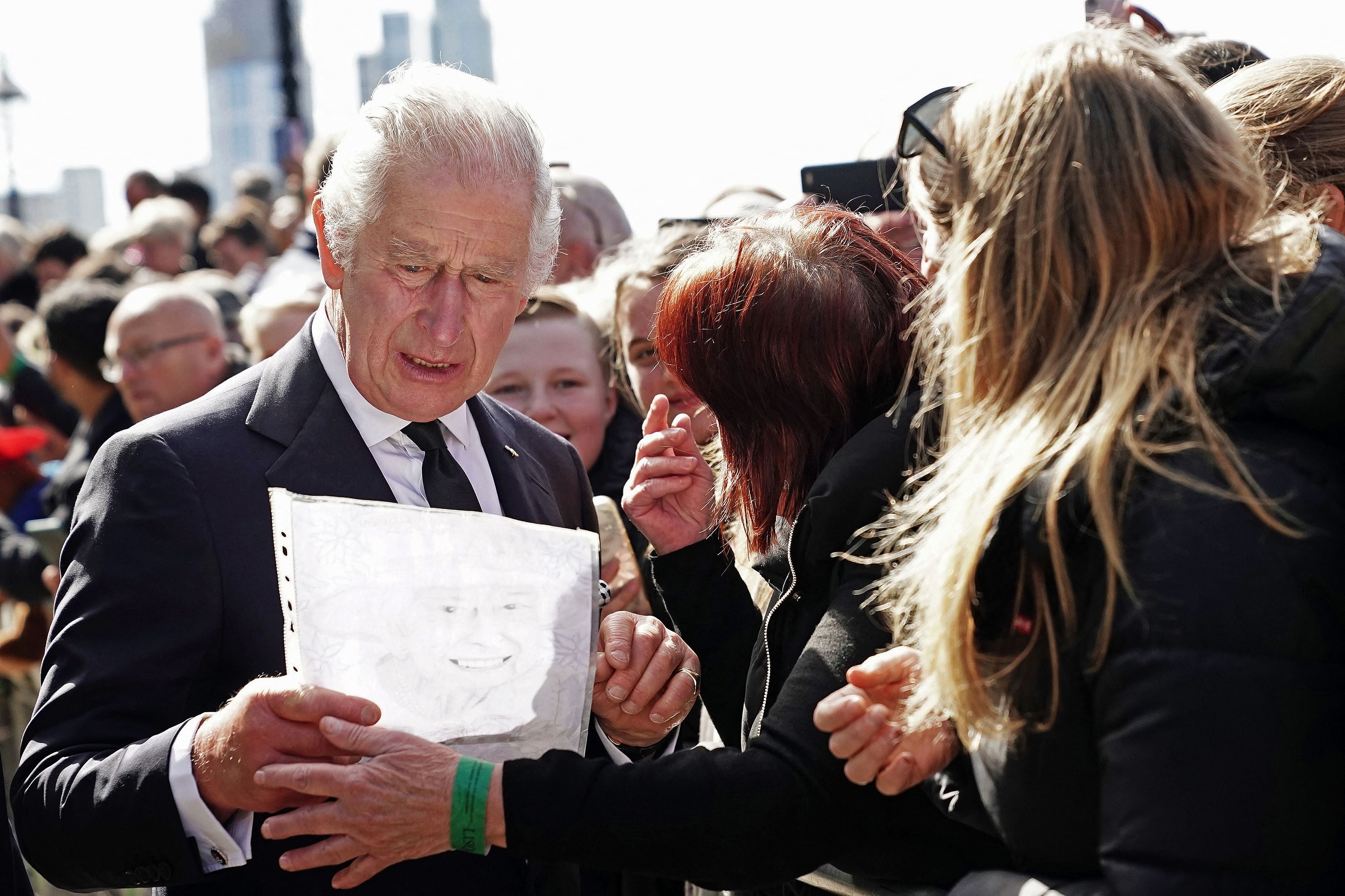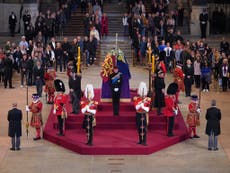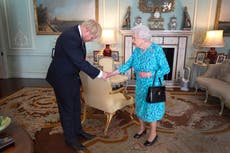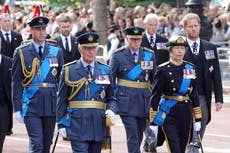The King needs the people at least as much as they need him
Imagine how much trouble the institution of the monarchy would be in if no one had flocked to the gates of Balmoral or Buckingham Palace after the Queen died; if only ministers and MPs had wanted to file past her coffin, writes Mary Dejevsky


Your support helps us to tell the story
From reproductive rights to climate change to Big Tech, The Independent is on the ground when the story is developing. Whether it's investigating the financials of Elon Musk's pro-Trump PAC or producing our latest documentary, 'The A Word', which shines a light on the American women fighting for reproductive rights, we know how important it is to parse out the facts from the messaging.
At such a critical moment in US history, we need reporters on the ground. Your donation allows us to keep sending journalists to speak to both sides of the story.
The Independent is trusted by Americans across the entire political spectrum. And unlike many other quality news outlets, we choose not to lock Americans out of our reporting and analysis with paywalls. We believe quality journalism should be available to everyone, paid for by those who can afford it.
Your support makes all the difference.The death of Queen Elizabeth II, at such a great age, after such a long reign, was always going to call for a unique solemnity and grandeur. That much was expected. Less expected, perhaps, was how many would rise so magnificently to the occasion.
There is the King, of course, who within hours of his mother’s death was transformed almost before our eyes into a more serious, more authoritative, and also somehow more approachable figure than he ever seemed to be as a prince. There is Princess Anne, as ever low-key, who accompanied her mother’s coffin to London and spoke of how fortunate she had been to share “the last 24 hours of my dearest mother’s life”, and of the “honour and privilege” it had been “to accompany her on her final journeys”.
Then there are the two princes, who had to replicate for their grandmother the long walk they had made as children behind their mother’s coffin. And, in the centre of everything, the dead Queen in her lead-lined coffin, draped in the royal standard, with the wreath, the crown, the sceptre and the orb – the accoutrements of power remaining, still, until she is buried at Windsor.
But another star has emerged over the past 10 days, shining, if anything, brighter than the others. And that star is the people. From one day to the next, the people have come out in ever greater numbers, with ever greater confidence; sometimes, it almost seemed – as when the King and the Prince of Wales went to meet some of those queueing to file past the Queen’s coffin – on an equal footing with royalty. Along with the extended hands, there was an assuredness, a cheerfulness, and an informality that seemed to speak of a new, less stuffy and more relaxed age.
We shall see, of course. But those encounters on London’s South Bank did not come completely out of the blue. They were the culmination of small episodes over a week in which monarchy and modernity seemed to meet. There were the crowds waiting for the Queen’s coffin at Buckingham Palace, who formed something akin to an impromptu guard of honour with their mobile phones. There were the drivers who screeched to a halt in the fast lane of the A40, when they realised that the Queen’s cortege was travelling towards them along the opposite carriageway, and jumped out of their cars to salute from the central reservation. (I know that road well, and watched the video clips in astonishment.)
There was the matter of Prince Harry’s military uniform. The King had apparently decided quite early on that the disgraced Prince Andrew, a helicopter pilot in the Falklands war, would be permitted to wear his ceremonial uniform – one last time? – to stand guard at the lying-in-state. That left Prince Harry, the only other member of the royal family to have seen active service, alone in being required to wear civilian dress.
It is reported that the initial decision was based on Harry no longer being a “working royal”. It is also reported that he did not make any request himself. So how come the King decided that Harry could, after all, wear his uniform to guard the Queen at her lying-in-state – albeit without the ER insignia? Could it be that he heeded rumblings in public opinion about the perversity of a situation where the only senior royals not wearing military uniform were those who had actually fought for Queen and country in real wars? Maybe that is not what happened, but perhaps it did.
Last, but not least, has been “The Queue”, hugging the South Bank of the Thames, at times right back to Bermondsey in the east. Even when the authorities tried to close it for a spell, as Southwark Park was judged to be at capacity, it regenerated itself by way of informal queues that effectively marshalled themselves.
Many have remarked on how much the queue came to resemble a pilgrimage, with the queuers’ singleness of purpose, their camaraderie along the way, and the charities and well-wishers offering victuals and encouragement through day and night. Southwark Cathedral also offered a refuge, marking a halfway point. All this is rather different, as I remember, from the queue for the Queen Mother’s lying-in-state. That snaked across two bridges, but those waiting were generally older, more formal in manner and dress, and more subdued for the whole distance. The difference is 20 years; a generation.
There is also the applause. The first time I can recall public applause at a royal funeral was when the crowd that had gathered outside Westminster Abbey clapped Earl Spencer’s tribute to his “hunted” sister, Princess Diana. It has now become a feature at funerals generally, but a sprinkling of applause from the public has followed the royal party around, including when they completed their stint standing guard at the coffin.
It is probably fair to say, too, that the bigger and more active role for the public – the people – over the days of national mourning for the Queen reflects lessons learned by the palace and the authorities generally from the mistakes made in handling the death of Diana.
To keep up to speed with all the latest opinions and comment, sign up to our free weekly Voices Dispatches newsletter by clicking here
The King’s very personal broadcast to the nation on the day after his mother’s death can be seen as one advance, as can the extensive engagement of the King and senior royals with the public across the UK. In terms of practicalities, the walking routes and the gardens organised in the royal parks for people to lay flowers have provided an elegant way of avoiding the mountains of flowers left for Diana, while the management of the queue surely also reflects new technical possibilities, now most people have mobile phones.
For me, though, the most striking aspect of everything that has happened over the past 10 days is the alacrity with which King Charles has been embraced by the people. Early enthusiasm, of course, may pall. Missteps could lead to the monarch forfeiting the enthusiastic goodwill that has passed – with as yet negligible public dissent – so directly from mother to son.
What can also be seen, however, is how far the power of the monarch – such as this exists in a constitutional monarchy – derives not just from the passive consent of the people, but from their acknowledgement and engagement. Just imagine how much trouble not just Charles, but the institution of the monarchy, would be in if no one had flocked to the gates of Balmoral or Buckingham Palace after the Queen died; if no one had tuned in to the King’s first broadcast; if no one, or only ministers and MPs, had wanted to file past her coffin.
In an age where communication is 24/7 and flows both ways, a modern monarch needs the people quite as much as they need the monarch; probably more. And the signs that the institution’s time is running out may be less about when rebellion stalks the land than when the people lose the sense that the monarch is somehow theirs.
The words and actions of Charles III since he became King suggest that he knows this, with his reign already having a different feel from that of his mother. But it is a sharp turn that leaves open the question of whether he will be able to carry on as he has begun. “Long live the King,” shouts the crowd. “Long live the people!” he needs to reply.



Join our commenting forum
Join thought-provoking conversations, follow other Independent readers and see their replies
Comments